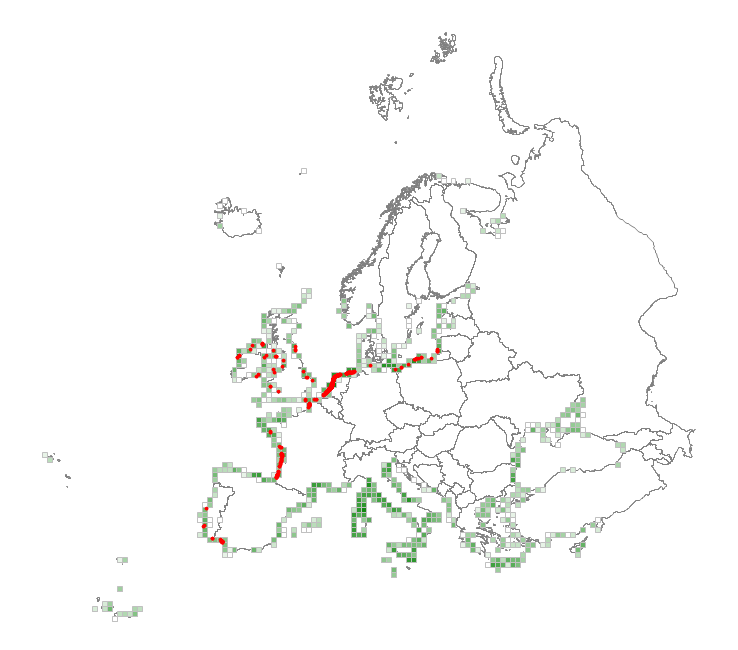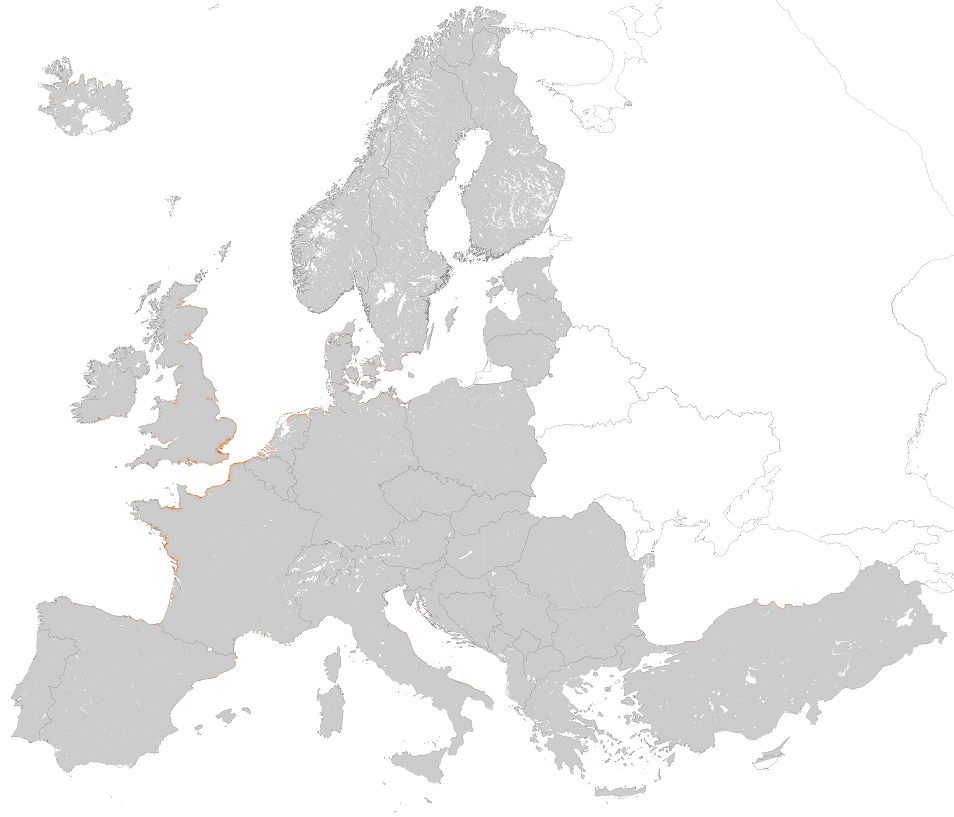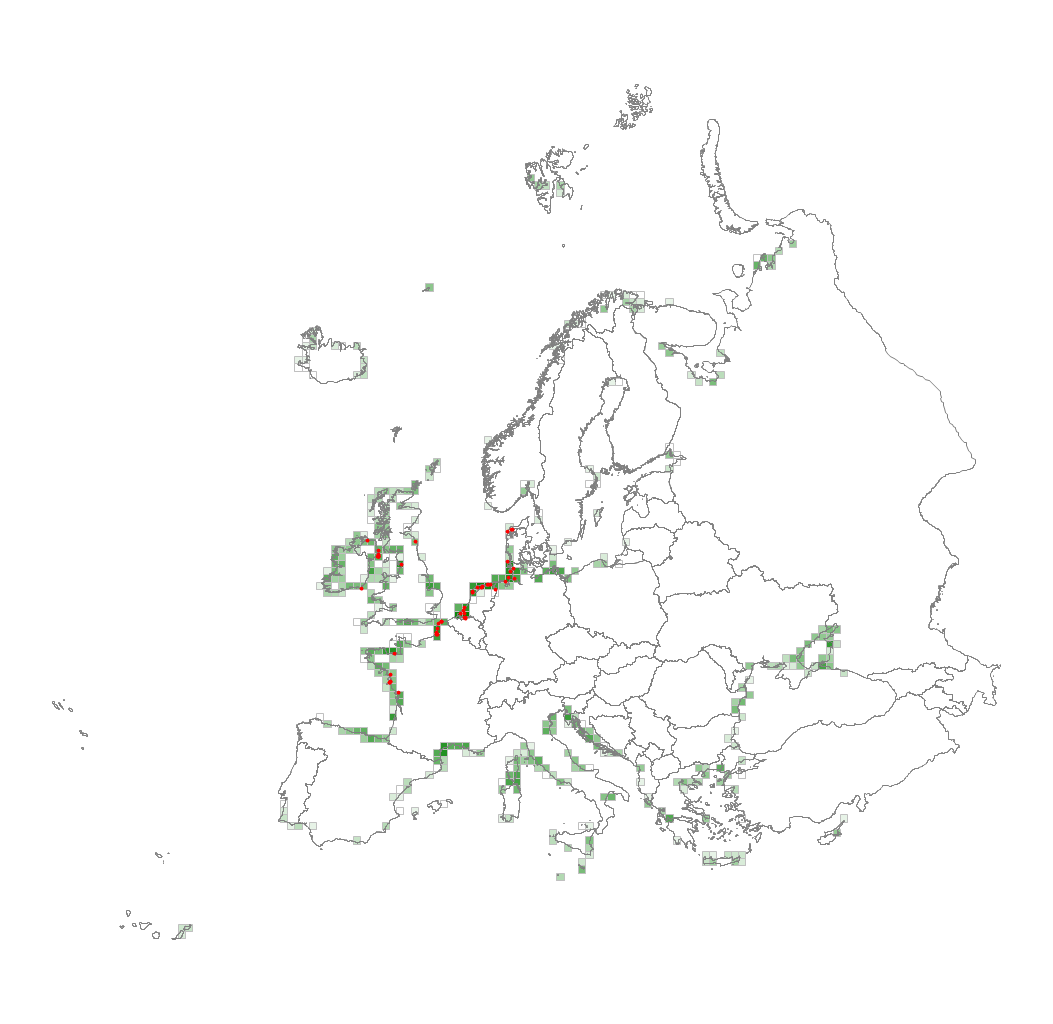habitat
Type of resources
Available actions
Topics
Keywords
Contact for the resource
Provided by
Years
Formats
Representation types
Update frequencies
status
Service types
Scale
Resolution
-

This metadata corresponds to the EUNIS Coastal habitat types, distribution based on vegetation plot data dataset. Coastal habitats are those above spring high tide limit (or above mean water level in non-tidal waters) occupying coastal features and characterised by their proximity to the sea, including coastal dunes and wooded coastal dunes, beaches and cliffs. Includes free-draining supralittoral habitats adjacent to marine habitats which are normally only very rarely subject to any type of salt water, in as much as they may be inhabited predominantly by terrestrial species, strandlines characterised by terrestrial invertebrates and moist and wet coastal dune slacks and dune-slack pools. Supralittoral sands and wracks may be found also in marine habitats (M). Excludes supralittoral rock pools and habitats, the splash zone immediately above the the mean water line, as well the spray zone and zone subject to sporadic inundation with salt water in as much as it may be inhabited predominantly by marine species, which are included in marine (M). The verified coastal habitat samples used are derived from the Braun-Blanquet database (http://www.sci.muni.cz/botany/vegsci/braun_blanquet.php?lang=en) which is a centralised database of vegetation plots and comprises copies of national and regional databases using a unified taxonomic reference database. The geographic extent of the distribution data are all European countries except Armenia and Azerbaijan. The dataset is provided both in Geodatabase and Geopackage formats.
-

This metadata corresponds to the EUNIS Littoral biogenic habitat (salt marshes) types, predicted distribution of habitat suitability dataset. Littoral habitats are those formed by animals such as worms and mussels or plants (salt marshes). The verified littoral biogenic habitat samples used are derived from the Braun-Blanquet database (http://www.sci.muni.cz/botany/vegsci/braun_blanquet.php?lang=en) which is a centralised database of vegetation plots and comprises copies of national and regional databases using a unified taxonomic reference database. The geographic extent of the distribution data are all European countries except Armenia and Azerbaijan. The modelled suitability for EUNIS saltmarsh habitat types is an indication of where conditions are favourable for the habitat type based on sample plot data (Braun-Blanquet database) and the Maxent software package. The modelled suitability map may be used as a proxy for the geographical distribution of the habitat type. However, note that it is not representing the actual distribution of the habitat type. As predictors for the suitabilty modelling not only Climate and Soil parameters have been taken into account, but also so-called RS-EVB's, Remote Sensing-enabled Essential Biodiversity Variables like Landuse, Vegetation height, Phenology, LAI(Leave Area Index) and Population density. Because the EBV's are restricted by the extent of the Remote Sensing data (EEA38 countries and the United Kingdom) the modelling result does also not go beyond this boundary. The dataset is provided both in Geodatabase and Geopackage formats. The Training map files show the modelled suitable distribution, omitting the 10% of occurrence records in the least suitable environment under the assumption that they are not representative of the overall suitable habitat distribution. The 10 percentile training presence is an arbitrary threshold which omits all regions with habitat suitability lower than the suitability values for the lowest 10% of occurrence records.
-

This metadata corresponds to the EUNIS Littoral biogenic habitat types (salt marshes), distribution based on vegetation plot data dataset. Littoral biogenic habitats (commonly known as salt marshes) are formed by animals such as worms and mussels or plants. The verified saltmarsh habitat samples used are derived from the Braun-Blanquet database (http://www.sci.muni.cz/botany/vegsci/braun_blanquet.php?lang=en) which is a centralised database of vegetation plots and comprises copies of national and regional databases using a unified taxonomic reference database. The geographic extent of the distribution data are all European countries except Armenia and Azerbaijan. The dataset is provided both in Geodatabase and Geopackage formats.
-

Natura 2000 Directive Oiseau et Habitat en Aquitaine. Fonds cartographique ®IGN-BD ALTI® 2013
-
Ce jeu de données identifie par des surfaciques 4 types de données concernant la nouvelle géographie prioritaire définie par l'État : - Les quartiers prioritaires (QP) : initialement au nombre de 35, sont passés en 2014 au nombre de 21. Ils se situent sur 14 des 28 communes de Bordeaux Métropole et ont été retenus sur la base d'un critère économique (niveau de revenu très bas de ses habitants). - Les territoires de veille : ce sont des territoires qui ont été classés dans un premier temps « quartiers prioritaires » et qui ont été exclus de la nouvelle géographie prioritaire définie par l'État en 2014 et sur lesquels la Métropole a décidé de maintenir son action dans le cadre du contrat de ville en les identifiant en tant que « territoires de veille ». - Les zones franches urbaines (ZFU) ou territoires entrepreneurs, qui sont des quartiers situés dans des zones dites sensibles ou défavorisées. Ces zones ont été définies à partir de critères prenant en compte le taux de chômage, la proportion des jeunes de moins de 25 ans et de personnes sorties du système scolaire sans diplôme ainsi que du potentiel fiscal de la commune. Les entreprises implantées ou devant s'implanter dans ces quartiers bénéficient d'un dispositif complet d'exonérations de charges fiscales et sociales pendant quelques années et doivent en contrepartie réserver une partie de leurs embauches aux habitants de ces quartiers. - Les Nouveaux Programmes de Renouvellement Urbains (NPNRU) - quartiers porteurs d'un projet de renouvellement urbain dans le cadre de l'ANRU (Agence Nationale pour la Rénovation Urbaine) Ces quartiers bénéficient de financements spécifiques permettant de soutenir et de développer leur attractivité (développement économique, création d'équipements publics, diversification de l'offre de logements, amélioration de la mobilité) Ces périmètres, et les interventions qui pourront y être menées, ont été inscrits dans un protocole de préfiguration signé le 12 juillet 2017 entre l'État, l'ANRU, les communes, les bailleurs concernés, la Métropole et les différents partenaires. Ces NPNRU ont été classifiés suivant 3 niveaux d'intervention : Opération d'intérêt national (OIN), Opération d'intérêt régional (OIR1), Opération d'intérêt local (OIR2).
-

Zonage composé de l'ensemble des périmètres de programme local de l'habitat (PLH) - Un PLH définit la politique de l'habitat sur un territoire intercommunal. Il vise à répondre aux besoins en logements (social ou non, locatif ou non), à favoriser la mixité sociale en assurant une répartition équilibrée et diversifiée de l'offre en logements au sein d'un territoire intercommunal et indique les moyens pour y parvenir. Sa procédure spécifique implique qu'il n'est porté que par un EPCI ayant la compétence PLH en association avec l'Etat. Un programme local de l'habitat dure généralement six ans. La loi Molle du 29 mars 2009 modifie la portée du PLH en le rendant beaucoup plus opérationnel et oblige les EPCI à détailler les objectifs à la commune. Le programme engage l'Etat, les communes, les intercommunalités et le cas échéant les conseils généraux délégataires des aides à la pierre. Les actions sont mises en oeuvre par les opérateurs : organismes de logement social, opérateurs professionnels privés, propriétaires occupants ou bailleurs. Ces données ne contiennent que les PLH en cours d'élaboration ou en vigueur, les anciens PLH (c'est à dire ceux qui sont terminés) étant archivés à un état annulé.
-
Plan local de l'habitat (PLH) de la Communauté d’Agglomération Côte Basque Adour. (métadonnée en cours)
-
donnée disponible : - Occupation du sol sur Oloron-Sainte-Marie - Flore d'Oloron-Sainte-Marie - Habitat linéaire d'Oloron-Sainte-Marie
-
Le plan local d'urbanisme (PLU) est un document d'urbanisme réglementaire qui traduit le projet d'aménagement et de développement de Bordeaux Métropole. Il est composé de plusieurs documents graphiques. Cette donnée représente, sous forme raster géoréférencé, les Servitudes d'Utilité Publique (article R.123-13 du CU). Ces données n'ont pas un caractère opposable, seul le PLU papier approuvé est opposable (contrôle de légalité).
-
Base de données sur les loyers privés de 1999 à 2010 pour les Pyrénées-Atlantiques issues des annonces dans les gratuits.
 Catalogue PIGMA
Catalogue PIGMA